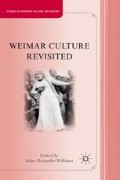Abstract
The sketch below (Figure 8.1), from Sozialistische Republik, the local organ of the German Communist Party (KPD) in Cologne, depicts the front line of communist struggle. Men and women clasp hands in defense of the working classes. Toward the center are two women standing strong and resolute alongside their male comrades. In this rendering and others like it, women were depicted as integral to the defense of the working classes, as emphasized in the accompanying caption: “Women and men of the proletariat must stand firmly together in the fight against hunger and immiseration.”
Access this chapter
Tax calculation will be finalised at checkout
Purchases are for personal use only
Preview
Unable to display preview. Download preview PDF.
Notes
See Werner T. Angress, Stillborn Revolution: The Communist Bid for Power in Germany, 1921–1923 (Princeton, 1963); Ben Fowkes, Communism in Germany underthe Weimar Republic (New York, 1984), 91–109.
Eric Weitz, Creating German Communism, 1890–1990 (Princeton, 1997)
Julia Sneeringer, Winning Women’s Votes: Propaganda and Politics in Weimar Germany (Chapel Hill, 2002), 100–7.
Quoted in Helen Boak, “Women in Weimar Germany: The ‘Frauenfrage’ and the Female” in Social Change and Political Development in Weimar Germany, ed. Richard Bessel and E. J. Feuchtwanger (Totowa, NJ, 1981), 157.
Silvia Kontos, Die Partei kämpft wie ein Mann: Frauenpolitik der KPD in der Weimarer Republik (Frankfurt, 1979).
For scholarship that examines women and gender among Weimar communists, see Karen Hagemann, “Men’s Demonstrations and Women’s Protest: Gender in Collective Action in the Urban Working-Class Milieu during the Weimar Republic,” Gender History (1993): 101–19; Atina Grossmann, Reforming Sex: The German Movement for Birth Control and Abortion Reform, 1920–1950 (New York, 1995), and “German Communism and the New Women: Dilemmas and Contradictions” in Women and Socialism/Socialism and Women, ed. Helmut Gruber and Pamela Grave (New York, 1998), 135–68; Mallmann, Kommunisten in der Weimarer Republik, 131–41; Weitz, Creating, 177–78, 216–17.
Weitz, Communism, 205. For an investigation of gender roles in the international communist movement in the early twentieth century, see Eric Weitz, “The Heroic Man and the Ever-Changing Woman: Gender and Politics in European Communism, 1917–1950” in Gender and Class in Modern Europe, ed. Laura Frader and Sonya Rose (Ithaca, 1996), 311–52.
On the New Woman in Weimar Germany, see Atina Grossman, “Girlkultur or a Thoroughly Rationalized Female: A New Woman in Weimar Germany?” in Women and Culture and Politics: A Century of Change, ed. Judith Friedlander, et al. (Bloomington, 1986), 62–80, and “The New Woman and the Rationalization of Sexuality in Weimar Germany” in Power of Desire: The Politics of Sexuality, ed. Ann Snitow, Christine Stansell, and Sharon Thompson (New York, 1983), 153–71.
For recent studies on masculinity during the Weimar Republic, see George Mosse, The Image of Man: The Creation of Modern Masculinity (New York, 1996); Sabine Kienitz, “Der Krieg der Invaliden: Helden-Bilder und Mannlichkeitskonstruktionen nach dem Ersten Weltkrieg,” Militärgeschichtliche Zeitschrift (2001): 367–402; David Bielanski, “Front Line Weimar: Paramilitary Mobilization and Masculine Representation in Postwar Germany” (Ph.D. Dissertation, University of Illinois, 2002); Karen Hagemann and Stefanie Schüler-Springorum, eds., Home/Front: The Military, War, and Gender in Twentieth-Century Germany (New York, 2002); Raymond Sun, “ ‘Hammer Blows’: Work, the Workplace, and the Culture of Masculinity among Catholic Workers in the Weimar Republic,” Central European History (2004): 245–71.
On the construction of militant masculinities in interwar Germany, see Bernd Hiippauf, “Langemarck, Verdun, and the Myth of a New Man in Germany after the First World War,” War & Society (1988): 70–103; Klaus Theleweit, Male Fantasies., trans. Erica Carter and Chris Turner (Minneapolis, 1988, two vols.); Stefanie Schüler-Springorum, “Flying and Killing: Military Masculinity in German Pilot Literature, 1914–1939” in Hagemann and Schiiler-Springorum, Home/Front, 205–32; Bernd Weisbrod, “Military Violence and Male Fundamentalism: Ernst Jünger’s Contribution to the Conservative Revolution,” History Workshop Journal (2000), 68–94.
On the RFB see Kurt Schuster, Der Rote Frontkämpferbund 1924–1929 (Düs-seldorf 1975); James Diehl, Paramilitary Politics in Weimar Germany (Bloom-ington, 1977); Günter Bers, ed., “Rote Tage” im Rheinland: Demonstrationen des Roten Frontkämpfer-Bundes im Gau MR 1925–1928 (Hamburg, 1980); Kurt Finker, Geschichte des Roten Frontkämpferbundes (Berlin, 1982).
Freya Eisner, Das Verhältnis der KPD zu den Gewerkschaften in der Weimarer Republik (Frankfurt, 1977), 97–113; Erika Kücklich and Stefan Weber, “Die Rolle der Betriebszellen der KPD in den Jahren der Weimarer Republik,” BzG (1980): 116–30; Weitz, Creating, 148–49, 155–56.
Gottfried Korff, “From Brotherly Handshake to Militant Clenched Fist: On Political Metaphors for the Worker’s Hand,” International Labor and Working-Class History (1992): 70–81.
Gottfried Korff, “Rote Fahnen und geballte Faust: Zur Symbolik der Arbeiterbewegung in der Weimarer Republik” in Transformation der Arbeiterkultur, ed. Peter Assion (Marburg, 1986), 93.
Vernon Lidtke, The Alternative Culture: Socialist Labor in Lmperial Germany (New York, 1985); Hans Joachim Teichler, ed., Arbeiterkultur und Arbeitersport (Clausthal-Zellerfeld, 1985).
W L. Guttsmann, Workers’ Culture in Weimar Germany (New York, 1990); Peter Friedemann, “Die Krise der Arbeitersportbewegung am Ende der Weimarer Republik” in Arbeiterkultur zwischen Alltag und Politik, ed. Friedhelm Boll (Vienna, 1986); Hartmann Wunderer, Arbeitervereine und Arbeiterparteien: Kultur- und Massenorganisationen in der Arbeiterbewegung (1890–1933) (Frankfurt, 1980).
For instance, Eve Rosenhaft, Beating the Fascists? The German Communists and Political Violence, 1929–1933 (New York, 1983); Anthony McElligott, Contested City: Municipal Politics and the Rise of Nazism in Altona, 1917–1933 (Ann Arbor, 1998).
Karl Marx, Class Struggles in France, 1848–1850 (New York, 1976), 59.
See Chris Bowlby, “Blutmai 1929: Police, Parties and Proletarians in a Berlin Confrontation,” The Historical Journal (1986): 137–58; Thomas Kurz, Blutmai: Sozialdemokraten und Kommunisten im Brennpunkt der Berliner Ereignisse von 1929 (Bonn, 1988).
Editor information
Editors and Affiliations
Copyright information
© 2011 John Alexander Williams
About this chapter
Cite this chapter
Sewell, S.A. (2011). The Party Does Indeed Fight Like a Man: The Construction of a Masculine Ideal in the Weimar Communist Party. In: Williams, J.A. (eds) Weimar Culture Revisited. Studies in European Culture and History. Palgrave Macmillan, New York. https://doi.org/10.1057/9780230117259_8
Download citation
DOI: https://doi.org/10.1057/9780230117259_8
Publisher Name: Palgrave Macmillan, New York
Print ISBN: 978-1-349-29215-8
Online ISBN: 978-0-230-11725-9
eBook Packages: Palgrave History CollectionHistory (R0)

